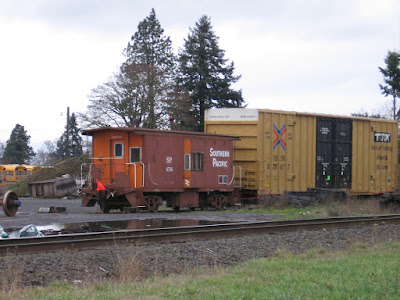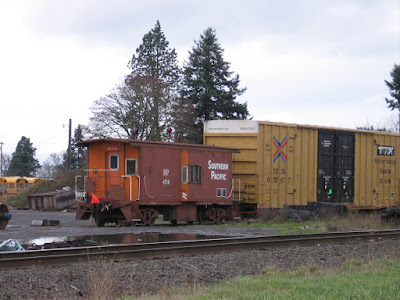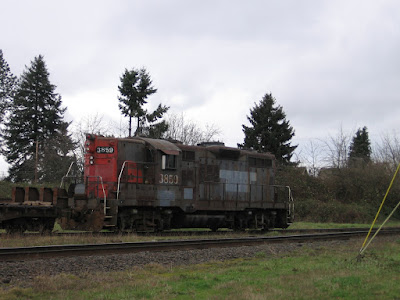 Photo by Cliff West
Photo by Cliff West
To commemorate the bicentennial of the Lewis and Clark Expedition, the Oregon Department of Transportation operated an excursion train along the south bank of the lower Columbia River from Linnton, near Portland, to Astoria, near the site of Fort Clatsop, where the Lewis and Clark Expedition wintered over in 1805-06. The train ran for the summers of 2003 to 2005, making one round trip on Fridays, Saturdays, Sundays and Mondays. My dad, Cliff West, took these pictures of the train during its final season in 2005, around July. These first pictures show the westbound train approaching Rainier.

Photo by Cliff West
Charles Fox founded Rainier in 1851. The town was originally called Eminence, but the name was changed to Rainier in 1852. The town is named after Rear Admiral Peter Rainier of the Royal Navy, for whom Mt. Rainier in Washington is also named. The town of Rainier was incorporated in 1885. According to the 2000 census, Rainier has a population of 1,687 people.

Photo by Cliff West
On another day, the westbound train is shown approaching Rainier from another vantage point.
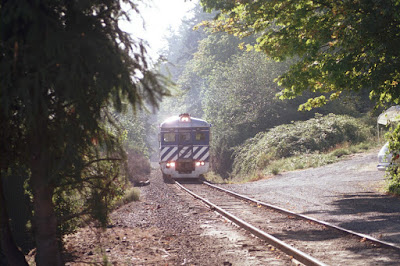
Photo by Cliff West
Rainier is my hometown, so it is covered more extensively than the other towns.

Photo by Cliff West
The railroad runs down the middle of A Street in downtown Rainier. Street-running used to be common for railroads in the United States, but today it is becoming rare.

Photo by Cliff West
Later in the season, around September 2005, the westbound Lewis & Clark Explorer passes Riverfront Park in Rainier.

Photo by Cliff West
On another day around September 2005, the westbound Lewis & Clark Explorer runs down East A Street.
The train consisted of three self-propelled passenger cars known as Rail Diesel Cars, or RDCs, introduced by the Budd Company in 1949 and built throughout the 1950s. Budd was a major builder of railcars at the time, specializing in stainless steel streamlined passenger cars. These cars were purchased by the state of Oregon's Department of Transportation from the British Columbia Railway, which had ended its passenger service in 2002.

Photo by Cliff West
RDC's are powered by 2 Detroit Diesel Series 110 V-6 engines, each producing about 275 horsepower, giving each RDC about 550 horsepower. This is enough power for an RDC to move itself rather quickly, however an RDC does not have much power for pulling additional cars. As a result, each RDC in a consist must be operational. RDCs have a control cab at each end, and a single RDC can control all the other RDCs coupled to it. The hump in the roof at the center of an RDC contains the exhaust and cooling for the engines, freeing up space inside the cars for passengers.

Photo by Cliff West
Leading the train, ORRX #31 is an RDC-3 originally built by Budd in July 1956 for the Great Northern Railway as #2350. The RDC-3 featured a section at one end of the car for baggage and mail. #2350 became Burlington Northern #2350 in 1970 and later became Amtrak #43. The British Columbia Railway purchased the car in January 1976 to replace their original #BC-31, which was destroyed in a fire on November 26, 1973. Trailing behind, ORRX #10 & #11 are RDC-1s built in August 1956 by Budd for British Columbia Railway's predecessor Pacific Great Eastern as #BC-10 and #BC-11. The RDC-1 was the passenger-only model of Budd's RDC line. The Pacific Great Eastern became the British Columbia Railway on April 1, 1972, when it was taken over by British Columbia's provincial government. The railroad began going by the name BC Rail on June 19, 1984. These RDC's are still in BC Rail paint, with only the BC Rail heralds replaced by the Lewis & Clark Explorer heralds.

Photo by Cliff West
On another sunnier day around September 2005, the westbound Lewis & Clark Explorer runs down East A Street.

Photo by Cliff West
How the three RDCs were coupled together varied. Sometimes the RDC-3 #31 was at one end, other times it was in the middle. The three were rarely separated, so they remained as they were coupled for quite a while.
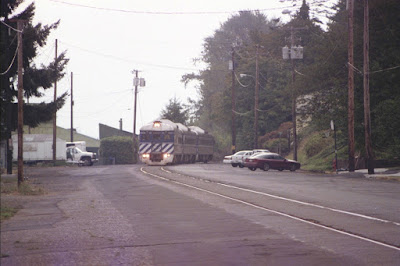
Photo by Cliff West
Near the end of the final season, in late September 2005, the westbound Lewis & Clark Explorer enters Rainier.
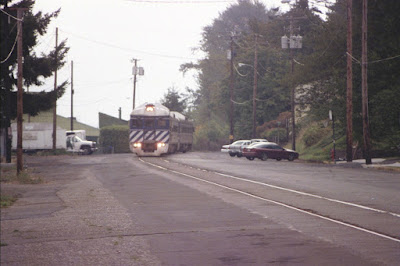
Photo by Cliff West
The Lewis & Clark Explorer was the first scheduled passenger service on this rail line since 1952.

Photo by Cliff West
Clatskanie takes its name from the Tlatskanai Indians, a very warlike tribe that inhabited this area. The Tlatskanai were wiped out by a smallpox epidemic in the 1850s. Clatskanie was first settled in 1852. It was originally called Bryantville. Clatskanie was incorporated in 1891. According to the 2000 census, Clatskanie has a population of 1,528 people. Unlike the other towns, which the railroad runs right through the middle of, the railroad only skirts along the edge of Clatskanie. At the west end of town, the railroad crosses the Clatskanie River on a swing-type drawbridge built in 1897.

Photo by Cliff West
This bridge must be manually swung by a handcrank in the center of the span. This is the first of three manual drawbridges the train crosses. The bridge is normally kept open for river traffic, and is only swung closed when a train is waiting.
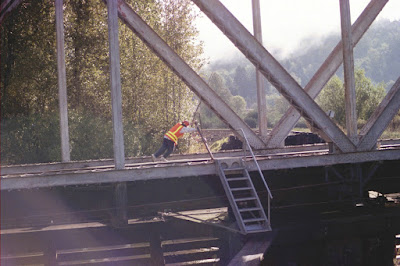
Photo by Cliff West
For freight trains, a railroad employee swings the bridge. For the Lewis & Clark Explorer, the bridge was swung by specially trained volunteers.

Photo by Cliff West
In these pictures, taken from the west side of the bridge, you can see the walkway to get to the span when the bridge is open, and the volunteer walking around the circular walkway in the middle, using the removable pole to turn the handcrank.

Photo by Cliff West
This is the bridge at which the Portland & Western freight train crew switching the Stimson Lumber mill at Clatskanie pushed a carload of lumber off the approach to the open drawbridge into the river on September 2, 2004. The train was operating on the east side of the bridge, so in the pictures it is the far approach that was damaged. Since the bridge was completely open at the time, the main span was not damaged.
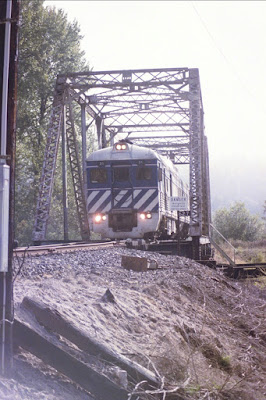
Photo by Cliff West
This damage to the bridge approach closed the line for the entire Labor Day weekend, forcing that weekend's trips of the Lewis & Clark Explorer to be cancelled. The bridge approach was repaired and the line reopened in time for the rest of the season to be completed.

Photo by Cliff West
Between Clatskanie and Westport the Astoria line closely parallels U.S. Highway 30. This picture shows the eastbound Lewis & Clark Explorer in this area.

Photo by Cliff West
John West settled in Westport in 1850. The post office opened in 1863. Westport is located on Westport Slough, a side channel of the Columbia River. This location shelters the shore at Westport from the current in the river's main channel, making the slough a relatively good place for boaters and fishermen. Since 1925, a car ferry has connected Westport with Puget Island. This small ferry operation proves itself essential when construction or another emergency temporarily closes one of the bridges at Rainier or Astoria. This picture shows the westbound Lewis & Clark Explorer as it moves through Westport.

Photo by Cliff West
The town of Knappa was named after Aaron Knapp, Jr., an early settler of the area. The Knappa post office operated from 1873 to 1943. The actual town of Knappa is actually a little inland from the river, and the railroad stays close to the river here and doesn't actually go through Knappa. Two roads cross the railroad at Knappa. Knappa Road crosses above the tracks on an old wooden overpass. Waterhouse Road crosses the tracks at a traditional grade crossing. But this grade crossing is unique; it is still protected by an antique railroad crossing signal known as a Magnetic Flagman or wigwag.

Photo by Cliff West
Just north of the tracks, Waterhouse Road turns to intersect with Knappa Road, which is just to the east. The Knappa Road overpass is adjacent to the Waterhouse Road crossing, making this a very photogenic spot for train photographs. Unfortunately, the Portland & Western has no freight business this far down the line, so without the Lewis & Clark Explorer train, this area sees almost no rail traffic.

Photo by Cliff West
This type of signal was manufactured by the Magnetic Signal Company of Los Angeles, California from 1910 to 1949. It takes its name from the movement it makes; the black and white banner with the red light in the middle swings, "wigwags" back and forth. The movement is similar to that made by a human flagman while swinging a flag or lantern to stop traffic. The signal also features a bell. This wigwag was removed in March of 2007.
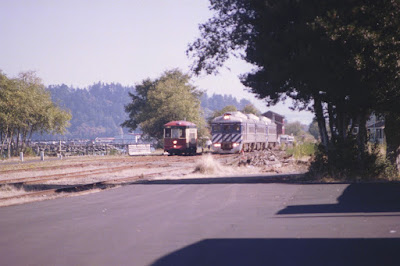
Photo by Cliff West
Astoria is the oldest settlement west of the Rocky Mountains. Fur traders sent by John Jacob Astor built Fort Astoria in 1811. Astoria is the county seat of Clatsop County. According to the 2000 census, Astoria has a population of 9,813 people.

Photo by Cliff West

Photo by Cliff West
The Lewis & Clark Explorer's journey ends, appropriately enough, in front of the old Astoria railroad depot. The depot was built in 1924, the peak year for rail travel in Astoria. The railroad continued to use the building for decades after passenger service ended, but today the building is owned by the Columbia River Maritime Museum. It is closed to the public as it is in need of serious repair and is only used for storage.

Photo by Cliff West
Back in Rainier on another, wetter day, the Lewis & Clark Explorer makes one of its last trips down the middle of A Street.

Photo by Cliff West
The ditch lights on the front of the RDC shined brightly on this gloomy day.
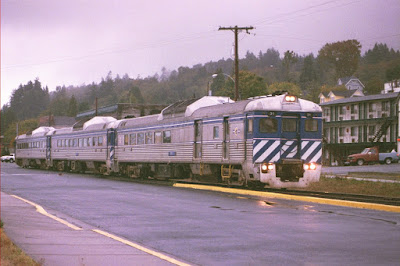
Photo by Cliff West
The street running in Rainier ended at West 2nd Street, and the rail line ran alongside a narrower A Street from there.

Photo by Cliff West
On another day near the end of the final season, the Lewis & Clark Explorer runs down A Street in Rainier.

Photo by Cliff West
At West 2nd Street, the train leaves the street and has its own separate right of way again.

Photo by Cliff West
After leaving the street-running behind, the railroad crosses over Fox Creek on an old wooden trestle that probably dates from the railroad's original construction in the 1890s.
I believe this was the last run of the Lewis & Clark Explorer on October 3, 2005.


